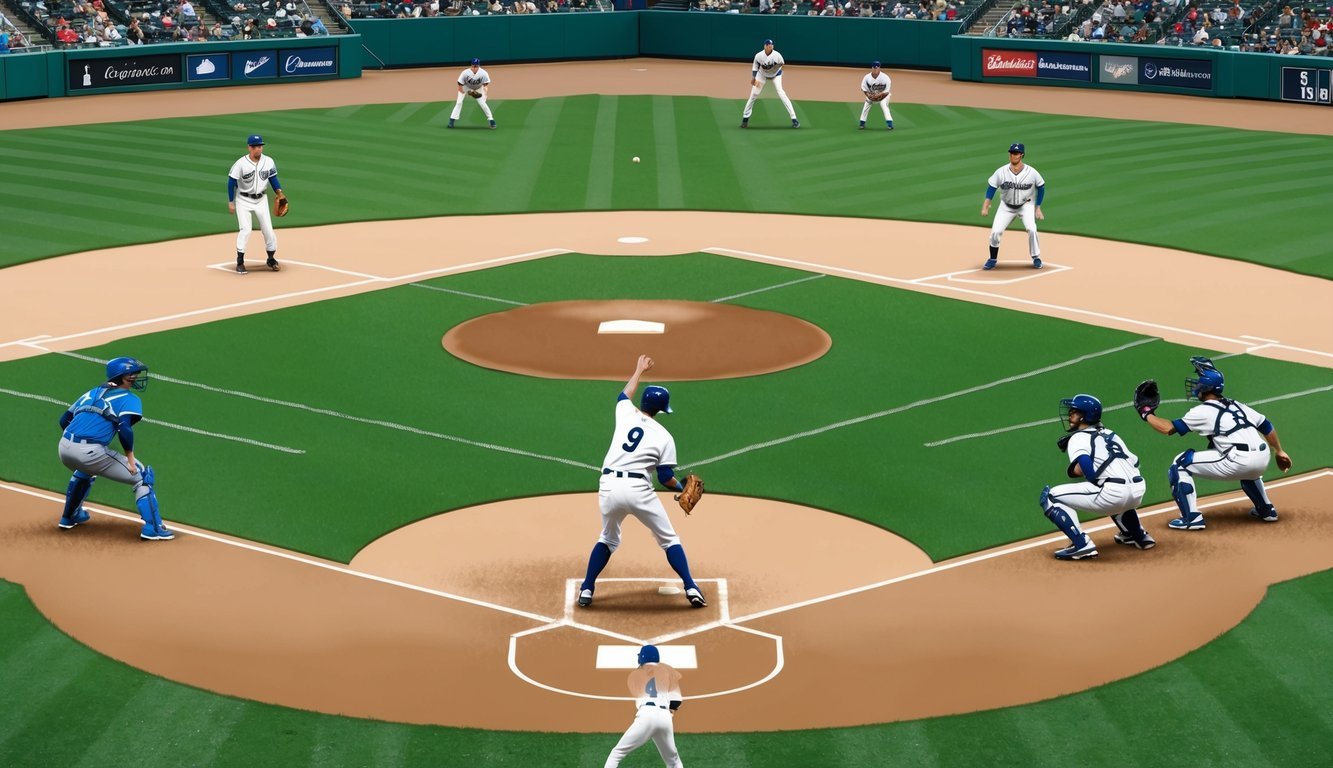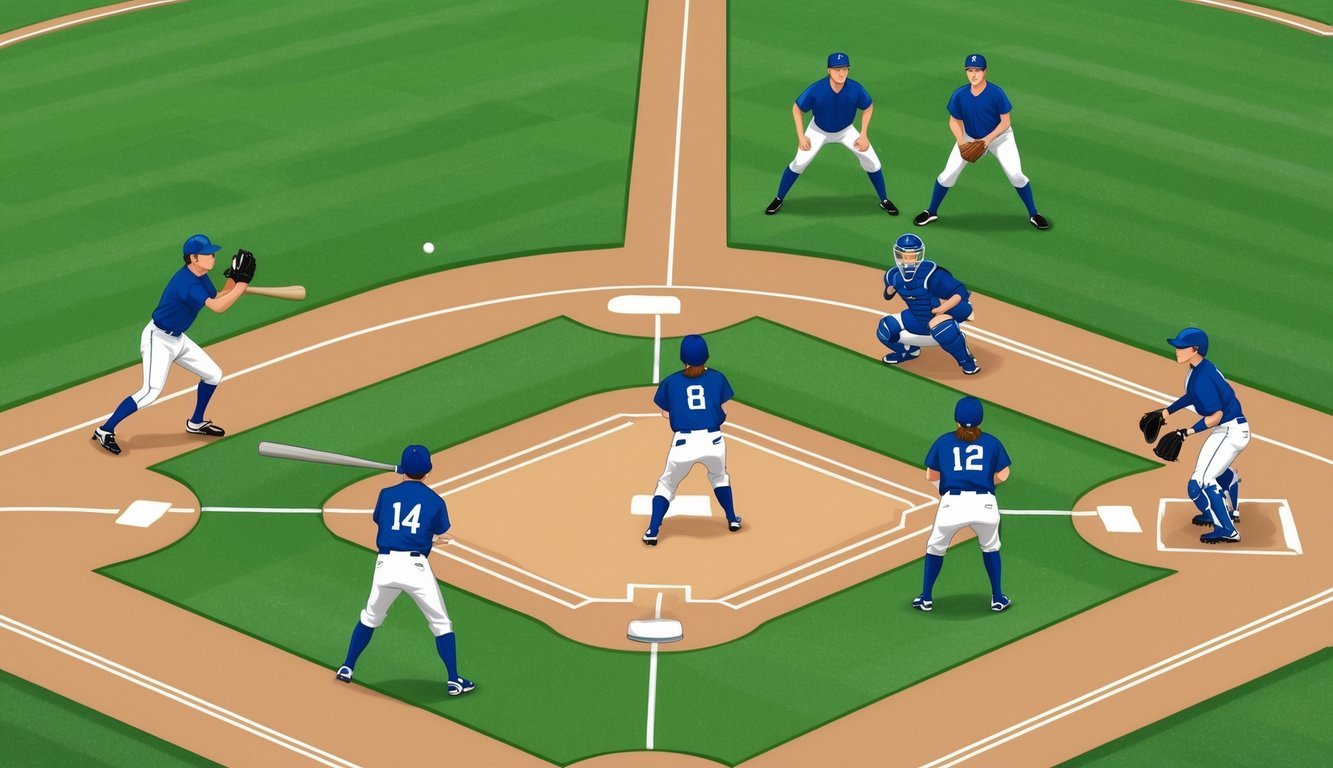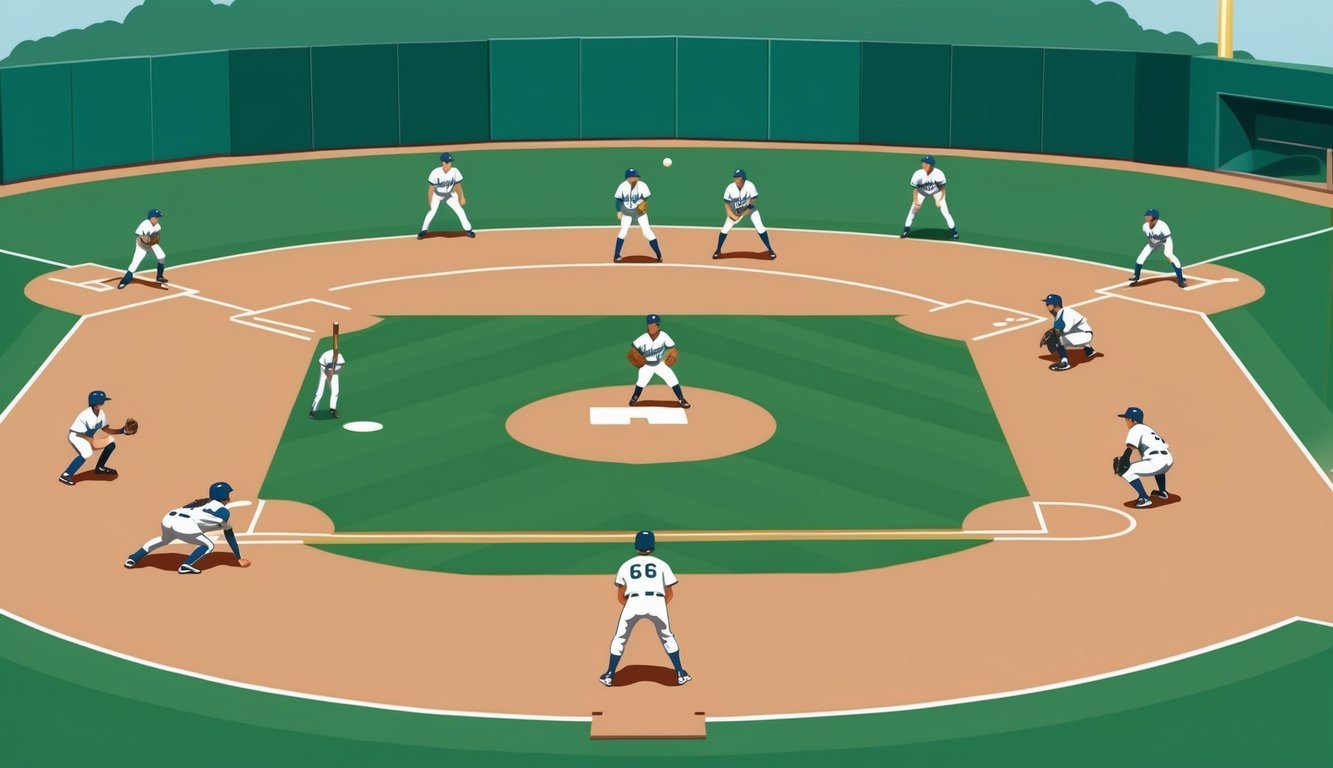Baseball is a beloved sport that combines skill, strategy, and excitement.
At its core, baseball pits two teams of nine players against each other on a diamond-shaped field. The object is simple: score more runs than the opposing team by hitting the ball and safely reaching base.
Players take turns batting and fielding.
When batting, the goal is to hit pitches thrown by the opposing pitcher and advance around four bases to score a run.
Fielders aim to prevent this by catching hit balls and tagging runners out.
The game unfolds through a series of at-bats, with teams switching roles after three outs.
Baseball’s charm lies in its blend of individual performance and team play.
Each pitch can lead to a game-changing moment, keeping fans on the edge of their seats.
From Little League to the Major Leagues, baseball’s rules and spirit remain constant, fostering a shared love for America’s pastime across generations.
Basics of the Game
Baseball is a strategic sport played between two teams, combining skill, teamwork, and precision.
The game revolves around scoring runs while preventing the opposing team from doing the same.
Objective and Team Roles
The main goal in baseball is to score more runs than the opponent.
Each team takes turns playing offense and defense.
The offensive team tries to score by hitting the ball and running around the bases.
The defensive team aims to prevent runs by getting the offensive players out.
On defense, players have specific positions on the field.
The pitcher throws the ball to the catcher, while other fielders try to catch or stop hit balls.
Infielders cover the bases and shortstop, while outfielders patrol the grassy area beyond the infield.
When batting, players take turns trying to hit the ball thrown by the pitcher.
If successful, they become baserunners, attempting to advance around the bases and ultimately score by reaching home plate.
Structure of Innings
A baseball game is divided into nine innings.
Each inning has a top and bottom half.
In the top half, the visiting team bats while the home team plays defense.
The roles switch for the bottom half.
An inning ends when the defensive team records three outs.
Outs can be achieved through various means:
- Strikeouts (batter misses three strikes)
- Fly balls caught by fielders
- Force outs at bases
- Tag outs on baserunners
Teams switch between offense and defense after three outs.
This back-and-forth continues for all nine innings.
Game Duration
Unlike many sports, baseball doesn’t have a set time limit.
A regulation game lasts nine innings, but can go longer if tied.
The game ends when one team leads after nine innings or in extra innings.
Professional games typically last around 3 hours, but can be shorter or longer.
Factors affecting game length include:
- Pitching changes
- Number of baserunners
- Scoring plays
- Weather delays
If a game is tied after nine innings, teams play extra innings until a winner is determined.
This unique aspect of baseball can lead to thrilling, extended contests that test players’ endurance and strategy.
The Playing Field and Equipment
Baseball’s iconic diamond shape and specialized gear are essential to the game.
The field layout and equipment used create the unique environment where America’s pastime unfolds.
Field Layout
The baseball field features a distinctive diamond shape with four bases.
Home plate sits at the front point, with first, second, and third bases forming the other corners.
The infield includes the diamond and pitcher’s mound, while the outfield extends beyond.
Foul lines run from home plate through first and third bases, defining fair territory.
Two white chalk lines form a 90-degree angle at home plate.
The distance between bases is 90 feet.
The pitcher’s mound stands 60 feet 6 inches from home plate.
Outfield dimensions vary by stadium but typically range from 300-400 feet from home plate.
Essential Gear
Baseball players rely on specific equipment to play safely and effectively.
The most crucial items include:
- Ball: A sphere about 9 inches in circumference, made of yarn wrapped around a cork center and covered in leather
- Bat: Usually made of wood, 2.75 inches in diameter at its thickest point
- Glove: Leather mitt with webbing between thumb and forefinger for catching
- Helmet: Worn by batters for protection against pitched balls
- Cleats: Shoes with spikes for traction on the field
Catchers wear additional protective gear, including a mask, chest protector, and shin guards.
Umpires use similar equipment when working behind home plate.
Rules of Play

Baseball has a set of fundamental rules that govern gameplay.
These rules cover how players get on base, score runs, and make outs – the core elements that determine the outcome of a game.
Getting On Base
Batters aim to reach base safely.
They can do this by hitting the ball into fair territory without being caught or thrown out.
A walk is another way to get on base, which occurs when the pitcher throws four balls outside the strike zone.
The strike zone is an imaginary box over home plate.
It extends from the batter’s knees to the midpoint between their shoulders and belt.
Pitches in this zone are called strikes if not hit.
Batters get three strikes before they’re out.
They can also get on base if hit by a pitch or due to defensive errors.
Scoring Runs
Runs are the points in baseball.
A team scores when a baserunner safely touches all four bases in order.
This typically happens when batters hit the ball well or through a series of successful plays.
Baserunners must tag up on fly balls.
This means they can’t advance until the ball is caught.
If the ball isn’t caught, they can run freely.
Home runs instantly score runs.
The batter and any runners on base all score when the ball is hit over the outfield fence in fair territory.
Getting Outs
Teams must record three outs to end an inning.
Strikeouts occur when a batter gets three strikes.
Fly outs happen when a fielder catches a batted ball before it touches the ground.
Force outs are made by touching a base while holding the ball before the runner arrives.
This applies when the runner must advance.
Tag outs involve touching the runner with the ball while they’re not on a base.
Runners are also out if they run outside the baseline to avoid a tag.
Ground outs occur when a batter hits the ball on the ground and is thrown out at first base before reaching it safely.
Player Positions and Responsibilities

Baseball features nine defensive positions, each with unique roles crucial to team success.
Players must master specific skills and work together to prevent the opposing team from scoring runs.
The Pitcher and Catcher
The pitcher stands on the mound and throws the ball to the batter, aiming to get outs.
Pitchers use various techniques and pitch types to outsmart batters.
They must have strong arms, precise control, and mental toughness.
Catchers crouch behind home plate, receiving pitches and calling the game.
They communicate with pitchers using hand signals and help strategize pitch selection.
Catchers also throw out base stealers and field short hits near home plate.
These two positions form the battery, working closely together throughout the game.
Their partnership is key to controlling the pace and flow of play.
Infield and Outfield Roles
Infielders cover the diamond’s inner area.
The first baseman fields grounders and catches throws for putouts.
Second basemen and shortstops turn double plays and cover steal attempts.
Third basemen guard the line and field bunts.
Outfielders patrol the grassy area beyond the infield.
Left and right fielders catch fly balls and throw to bases to prevent extra bases.
Center fielders cover the most ground, often making spectacular catches.
All fielders must be alert and ready to react quickly.
They shift positions based on batter tendencies and game situations.
Good fielding requires agility, arm strength, and tactical awareness.
Teams in the American League can use a designated hitter to bat in place of the pitcher, focusing solely on offensive production.
Advanced Play and Strategy

Baseball strategy involves intricate offensive and defensive tactics that can make the difference between winning and losing.
Teams employ various techniques to gain an advantage during crucial moments of the game.
Offensive Tactics
Batters and baserunners use clever tactics to outsmart the defense.
A smart batter might bunt to advance runners or hit to the opposite field to beat the shift.
Baserunners often attempt steals to get into scoring position.
Double steals can catch the defense off guard.
The hit-and-run play combines baserunning and batting strategy to create scoring opportunities.
Sacrifice flies allow runners to advance or score after tagging up.
Teams may use pinch hitters in key situations to gain a matchup advantage.
The squeeze play, where a batter bunts as a runner breaks for home, can be a high-risk, high-reward option.
Defensive Strategy
Defensive positioning is crucial in baseball.
Infielders might play in to prevent a run or back for a double play.
Outfielders adjust their depth based on the batter and game situation.
The shift, where fielders drastically reposition for pull hitters, has become common in modern baseball.
Pitchers and catchers work together on pitch selection and location to keep batters guessing.
Defensive alignments change with runners on base.
Cut-off plays and relay throws help control the running game.
Infielders practice turning double plays smoothly to end innings quickly.
Managers make strategic pitching changes to create favorable matchups.
The use of specialized relievers in specific situations has evolved the game’s late-inning strategies.
